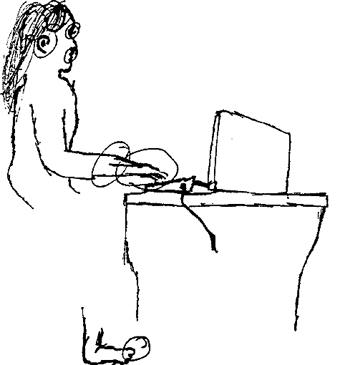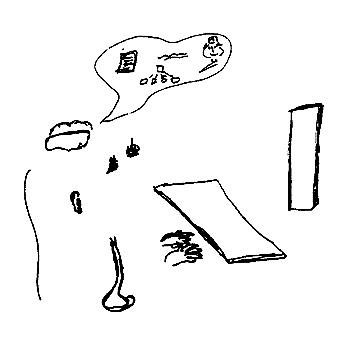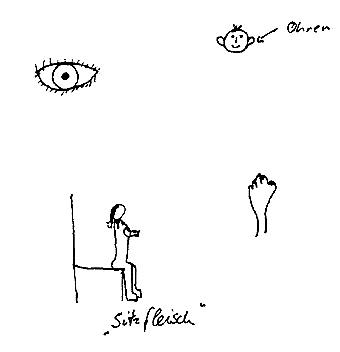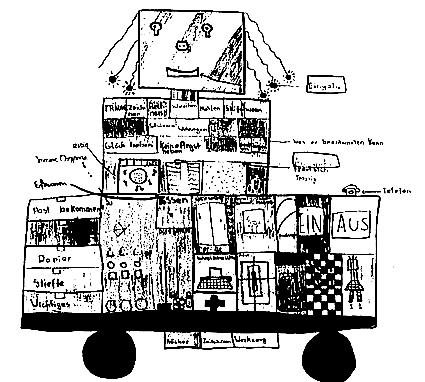
My considerations are based on an empirical study of the actions of female software developers and Artificial Intelligence researchers. The women reported in interviews how they develop computer programs and medical expert systems, which competencies are necessary for constructing virtually real worlds, and how they experience working in these worlds. They visualized their body sensations in drawings of their bodies.
I analyzed the data with regard to the following questions: Does the production of and acting within virtual worlds make it possible for these individuals to develop new self-representations aside from the traditionally determined ones? Are there chances for new sexual identities in a psychosocial and biological sense? I ask this from a discourse-theoretical perspective. Discourses produce and occupy reality; social reality, but also bodies as Judith Butler showed. Discourses are instilled with power; they define and regulate reality. The discourse of the sexes claims two genders as the norm; it clearly differentiates between male and female tasks, characteristics, and abilities. It creates the male and female body. Gender and sex are inseparable; both are normative (cf. Lorey, 1995, pp. 24-25). New sex identities have to be developed aside from this discourse and have to block out this takeover.
Postulate 1:
The career decision of software developers signalizes a rejection of the prevailing gender discourse.
Computer technology has a tradition of rationalization; of materializing the figures of a discourse based on principles that Max Weber referred to as rationale. Women were and are involved in this discourse (cf. Hoffmann 1987) while being partially shut out from it at the same time. The program of gender-specific division of labor based on two sexes gives the female primarily tasks in social areas - in contrast with the discourse of occidental rationality - i. e. care, health care and reproduction. The female life projection resulting from gender-specific division of labor was rejected by the software developers interviewed at the time when they were young girls (cf. Schachtner, 1995, pp. 105-106). "I knew when I was three that I never wanted to become a housewife" reported one developer. On the other hand, they were fascinated by the world they experienced through their fathers, the world of natural sciences. Their heightened interest in this world was due to the attempt to get away from the traditional female role but also to the special demands that working in a scientific-technological area placed upon them intellectually. The developers emphasize their early joy in arithmetics, in abstraction, in structuring, in identifying cause-effect relationships, in effective action. By training and educating these competencies in apprenticeship and profession, they crossed barriers; they realized themselves in ways not traditionally intended for females.
Postulate 2:
The gain in autonomy is counterbalanced by a risk of new determiners.
This risk is seen in the bodily representations of the software developers who answer the question: Which part of me is involved when I program? (cf. Schachtner, 1995, pp. 152-153). The views are dominated by heads and brains; the body recedes into the background. Atrophied bodies can frequently be seen; bodies which have no contours as your eye follows them down, which are reduced to a single line.

Sometimes the bodies vanish into the functional parts: a brain, an eye, an ear, a hand, a finger.

The pictures document the pushing back, the fragmentation, the functionalism of the mind and of the body.

The developers' plunging into the discourse of occidental rationality open both, on the one hand, new degrees of freedom, and at the same time, on the other hand, body and soul modeled according to the implications of rational logic. The identity is still bound to a discourse that subjects the individual.
Postulate 3:
The new machine constitutes, regardless of its implications, room for new kinds of identity experiments.
The virtual reality on the computer screen is created by joining hard and software. Software developers continually join their thinking with their material counterparts. Something that a moment previously was a part of an internal world is suddenly a part of the external on the computer screen. There is an intermediary spot where the subjective and the objective meet. The boarders between the internal and external, between the material and non-material, between animate and inanimate become fluid. The order of dominant discourse cease to be effective leaving a chance for contradictory orientation and interaction forms. The software developers take advantage of this opportunity. They temporarily turn the machine into a second self or counterpart. They lose their bodily limits in the machine or in the scenarios created on the screen (cf. Schachtner, 1993, pp. 30-31). They develop forms of interaction which can no longer be clearly assigned because they alternate between rationality and emotionality, between aggression and tenderness. They are directed at the inanimate as well as the animate. The virtual space - as an intermediary space - provokes and collects the unclear, the controversial, the confusing, the process.
Postulate 4:
The successful application of the rules of practical logic confirms the software developers' sense of self-esteem; transcending the rules fascinates them - activity attempts on the far side of discourse determinations.
The following examples represent various forms of oppositional speech and activity in the process of making and doing in virtual realities.
Fifteen-year-old Eva gives her machine various identities according to what currently moves her or who she currently has a crush on. First her machine was named "Andi and Gonzo and then renamed my dancing partner Marvin over at the Chacha", explains the 15-year-old. She ignores the fact that the machine is a thing, transforms the machine into a person and then into another, and then again in another and then turning him into a dance. This thing that she is dealing with is continually changing form: machine, person, movement. What does this mean for her identity?
It is conceivable that she identifies with her constructions and thus continually re-designs herself or even interacts with them. With Andi, Gonzo and Marvin she may possibly interact as a girl. But what role does she play when she transforms the machine into a dance?
For 16-year-old Jane, the computer is neither a machine nor a person, but rather something completely different, a third entity. She says, "The computer is not really a person but, hey, ... I don't know, you enter something and it comes back with something, but still it's not a person. The interesting thing is that it's something else." In an attempt to describe the potential of this new type of being she nullifies the rule of separating the living from the non-living. The being she imagines calls for new terminology that do not mean anything definite. For the time being, she call this creature an "in-between thing", in the long run she wants to find a name "that hasn't been invented yet."

The 16-year-old uses the machine as a means of contemplating beyond the established normal identities. She creates an identity which goes against being a unit, clearly defined and clearly limited, something that could become a model for her.
Example 3: Dissolving of one's own bodily limits into the material and non-material machine
Dipping into the intermediary space permanently provokes a dissolving of one's boarders. The software developers become engrossed in their computers or with their programs, sometimes with both.
One AI researcher names the expert system she developed after herself and, in her imagination, she is also a part of this system or computer; she does not exactly say which; she says "I'm pecking away at Bettina all the time" and "That's me now" referring to the computer. Whereas in the two former examples the identity experiments were undertaken with a machine counterpart, the AI researcher explicitly places herself in the mental experiment. She constructs a man-machine being which includes her spirit but also her bodily self. In her imagination, she goes out of herself into a form that of "an arm, a mechanical arm that reaches outward and has the ability to store and to calculate and to look at its results." Humanity and machine flow into each other. The fantasy documents that the bodily and mental self cannot be separated; neither the mind nor the body alone are permeated and formed by goals. The AI researcher reacts ambivalently to her hybrid construction. She is uncomfortable with it, she describes it as eerie. This feeling could be explained by the confrontation with broken taboos. On the other hand, she remarks "I had the most pleasant feeling while I did it".
It becomes apparent that the software developers comment differently about their experiences with ambiguous events in software production than about successful application of rules in rational logic. They feel confirmed by the latter; they describe the former as stimulating, exciting, "as the really thrilling part of the story". This confirms the fascination with the possibility of countering established discourse limits, hierarchies and divisions, to stroll in intermediary worlds and to play with intermediary existences. The male and female categories scarcely exist in this game which is not surprising as the game is above these categories. It is exactly this fact that provides new opportunities for the software developers; opportunities to view their experience in a new way and to re-contemplate their identity.
To summarize: the experience of the software developers moves between deconstruction and construction. Entering into the world of rational logic allows them to re-design the traditional determination of femininity. The newly-won freedom is surrounded by new constraints caused by the collective tendencies of rational logic. These in turn correspond to the intermediary space as a condition for identity designs which clash with the current order of discourse. They come about in play but could have serious consequences. This is what makes them both disquieting and fascinating.
Gunzenh&aauml;user, R. 1995: Gibt es eine Position außerhalb des Diskurses? Zu Michel Foucault und Donna Harraway," in: E. Haas (ed.) Verwirrung der Geschlechter - Dekonstruktion und Feminismus, München/Wien
Lorey, I. 1995: Immer Ärger mit dem Subjekt: Warum Judith Butler provoziert, in: E. Haas (ed.) Verwirrung der Geschlechter - Dekonstruktion und Feminismus, M6uuml;nchen/Wien
Schachtner, Ch. 1993: Geistmaschine. Faszination und Provokation am Computer, Frankfurt/Main
Schachtner, Ch. 1995: Softwareentwicklerinnen. Zur lebens&aauml;nglichenKonstitution eines Berufes, Psychosozial Nr. IV.